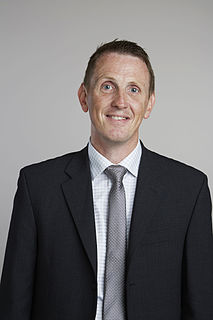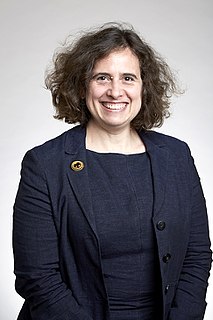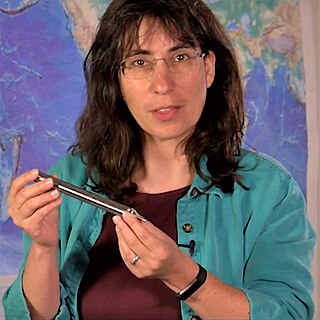Related Research Articles

Seismology is the scientific study of earthquakes and the propagation of elastic waves through the Earth or through other planet-like bodies. The field also includes studies of earthquake environmental effects such as tsunamis as well as diverse seismic sources such as volcanic, tectonic, glacial, fluvial, oceanic, atmospheric, and artificial processes such as explosions. A related field that uses geology to infer information regarding past earthquakes is paleoseismology. A recording of Earth motion as a function of time is called a seismogram. A seismologist is a scientist who does research in seismology.
Jennifer Alice Clack, FRS was an English palaeontologist, an expert in the field of evolutionary biology. She remains one of the preeminent workers known for studying the early evolution of tetrapods, specifically studying the "fish to tetrapod" transition: the origin, evolutionary development and radiation of early tetrapods and their relatives among the lobe-finned fishes. She is best known for her book Gaining Ground: the Origin and Early Evolution of Tetrapods, published in 2002 and written with the layman in mind.

Earth's inner core is the innermost geologic layer of the planet Earth. It is primarily a solid ball with a radius of about 1,220 km (760 mi), which is about 20% of Earth's radius or 70% of the Moon's radius.

Philip Conrad James Donoghue FRS is a British palaeontologist and Professor of Palaeobiology at the University of Bristol.
Trudy Frances Charlene Mackay is the director of Clemson University's Center for Human Genetics located on the campus of the Greenwood (S.C.) Genetic Center. She is recognized as one of the world's leading authorities on the genetics of complex traits. Mackay is also the Self Family Chair in Human Genetics and Professor of Genetics and Biochemistry at Clemson University.
Roger Everett Summons is the Schlumberger Professor of Geobiology at the Massachusetts Institute of Technology and Professor of Geobiology in the Department of Earth, Atmospheric and Planetary Sciences.
Stephen Mann, FRS, FRSC, is Professor of Chemistry, Director of the Centre for Organized Matter Chemistry, Director of the Centre for Protolife Research, and was Principal of the Bristol Centre for Functional Nanomaterials at the University of Bristol, UK.

Anne Carla Ferguson-Smith is a mammalian developmental geneticist. She is the Arthur Balfour Professor of Genetics, Head of the Department of Genetics at the University of Cambridge and a Fellow of Darwin College, Cambridge.
Franz Daniel Kahn (1926–1998) was a mathematician and astrophysicist at the University of Manchester. He was Professor of Astronomy from 1966 to 1993, then Emeritus thereafter in the School of Physics and Astronomy.

Neil Burgess is a Professor of Cognitive neuroscience at University College London and a Wellcome Trust Principal Research Fellow. He has made important contributions to understanding memory and spatial cognition by developing computational models relating behaviour to activity in biological neural networks.
Lucy Jane Carpenter is professor of physical chemistry at the University of York and director of the Cape Verde Atmospheric Observatory (CVAO).
Brian Leslie Norman Kennett is a mathematical physicist and seismologist. He is now a professor emeritus at the Australian National University.
Martha Kane Savage is a New Zealand geology academic, and as of 2018, is a full professor at the Victoria University of Wellington.

The lower mantle, historically also known as the mesosphere, represents approximately 56% of Earth's total volume, and is the region from 660 to 2900 km below Earth's surface; between the transition zone and the outer core. The preliminary reference Earth model (PREM) separates the lower mantle into three sections, the uppermost (660–770 km), mid-lower mantle (770–2700 km), and the D layer (2700–2900 km). Pressure and temperature in the lower mantle range from 24-127 GPa and from 1900-2600 K. It has been proposed that the composition of the lower mantle is pyrolitic, containing three major phases of bridgmanite, ferropericlase and calcium-silicate perovskite. The high pressure in the lower mantle has been shown to induce a spin transition of iron-bearing bridgmanite and ferropericlase, which may affect both mantle plume dynamics and lower mantle chemistry.

Emily E. Brodsky is a Professor of Earth Sciences at the University of California, Santa Cruz. She studies the fundamental physical properties of earthquakes, as well as the seismology of volcanoes and landslides.
Charles Bangham holds the Chair in Immunology at Imperial College London.
Matthew Edward Hurles is head of human genetics at the Wellcome Sanger Institute and an honorary professor of Human Genetics and Genomics at the University of Cambridge.
Leonid A. Sazanov is a Professor at the Institute of Science and Technology Austria (IST). Sazanov research explores the structure and function of large membrane protein complexes from the domain of bioenergetics. These molecular machines interconvert redox energy and proton motive force across biological membranes using a variety of mechanisms.
(Thomas) Martin Embley is a Professor at Newcastle University who has made contributions to our understanding of the origin of eukaryotes and the evolution of organelles such as mitochondria, mitosomes and hydrogenosomes, that are found in parasitic protists.
Gregory D. Scholes is William S. Tod Professor of Chemistry at Princeton University.
References
- 1 2 3 Kendall, John-Michael (1992). Contributions to the theory and modelling of seismic waves in anisotropic inhomogeneous media with applications to subduction-zones. queensu.ca (PhD thesis). Queen's University. OCLC 28669169.
- 1 2 "Department of Earth Sciences » Professor Michael Kendall joins Oxford Earth Sciences". earth.ox.ac.uk. Oxford.
- 1 2 John-Michael Kendall publications indexed by Google Scholar

- 1 2 Kendall, J.-M.; Silver, P. G. (1996). "Constraints from seismic anisotropy on the nature of the lowermost mantle". Nature. 381 (6581): 409–412. doi:10.1038/381409a0. ISSN 0028-0836. S2CID 4281356.
- 1 2 Wookey, James; Stackhouse, Stephen; Kendall, J-Michael; Brodholt, John; Price, G. David (2005). "Efficacy of the post-perovskite phase as an explanation for lowermost-mantle seismic properties". Nature. 438 (7070): 1004–1007. doi:10.1038/nature04345. ISSN 0028-0836. PMID 16355222. S2CID 4351425.
- 1 2 3 4 5 Kendall, John-Michael (2019). "Professor Mike Kendall FRS". johnmichaelkendall.com. Archived from the original on 2019-11-05.
- ↑ Anon (2019). "Professor John-Michael Kendall FRS". royalsociety.org. London: Royal Society. Archived from the original on 2019-04-24. One or more of the preceding sentences incorporates text from the royalsociety.org website where:
“All text published under the heading 'Biography' on Fellow profile pages is available under Creative Commons Attribution 4.0 International License.” --Royal Society Terms, conditions and policies at the Wayback Machine (archived 2016-11-11)
- ↑ John-Michael Kendall on Twitter

- ↑ Kendall, J-M.; Thomson, C. J. (1989). "A comment on the form of the geometrical spreading equations, with some numerical examples of seismic ray tracing in inhomogeneous, anisotropic media". Geophysical Journal International. 99 (2): 401–413. doi: 10.1111/j.1365-246X.1989.tb01697.x . ISSN 0956-540X.
- ↑ John-Michael Kendall publications indexed by the Scopus bibliographic database. (subscription required)
- ↑ Al-Harrasi, Othman Harith (2010). Fractured reservoir characterisation using shear-wave splitting in microseismic data : a case study from Oman. bristol.ac.uk (PhD thesis). University of Bristol. hdl:1983/30288fe4-70c5-4284-afeb-adab400ed4c6. OCLC 757129763. EThOS uk.bl.ethos.529853.

- ↑ Kendall, J.-M.; Stuart, G. W.; Ebinger, C. J.; Bastow, I. D.; Keir, D. (2005). "Magma-assisted rifting in Ethiopia". Nature. 433 (7022): 146–148. doi:10.1038/nature03161. hdl: 2158/1078050 . ISSN 0028-0836. PMID 15650736. S2CID 1290686.
- ↑ Teanby, N. A.; Kendall, J.-M.; van der Baan, M. (2004). "Automation of Shear-Wave Splitting Measurements using Cluster Analysis". Bulletin of the Seismological Society of America. 94 (2): 453–463. doi:10.1785/0120030123. ISSN 0037-1106.